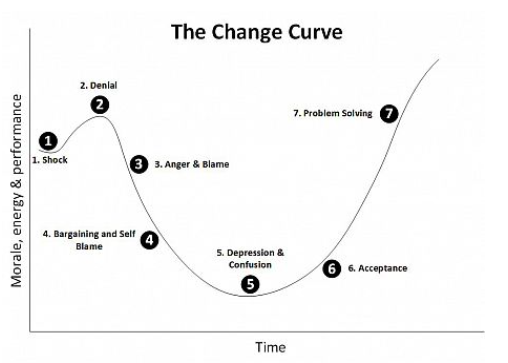At work you are getting a new CEO. They have been brought in to improve things. It feels like a big wave of change coming towards you.
Whatever the prompt: to keep up with customer expectations, technology advances, social change, revenue, profitability, global growth, all or any of these, your new CEO wants and has been hired to deliver significant change.
It’s not easy though, is it? You and your team all have different reactions to change. In this case it may be that you:
- agree with the changes and can see the rationale
- agree with the changes but don’t like how s/he is communicating with you
- actively disagree with what’s happening and fundamentally think the changes are wrong.
Whatever your views, your manager expects you to get on board, engage your team, join in and deliver. The change is going to happen.
There are a number of tools to help. The really obvious one is the Change Curve, which helps you process where you might be emotionally with the change:
As you know, there are still problems though, and it’s not that simple. You seem to vary where you are on this curve; moment to moment, meeting to meeting, email to email. Your feelings fluctuate as you understand more about the change needed and it can seem like you are going round and round.
It’s not just you; your colleagues and own team vary too. One moment you’re optimistic and they are low; next day, it’s the other way round.
Finally, one day, the penny drops.
It’s not how to accept change from above, or how to willingly cascade the change within the organisation, it is about how we choose to respond.
How we respond – choose – and claim or reclaim our agency – this is what makes the difference, not when we are feeling jerked out of place, or reacting to, each new announcement.
How we talk to each other about the changes and what we are feeling can really make a difference; it’s essential to improve the dialogue about how we feel.
If you are in this position, that of having a new CEO or Director, or there is a different source of change in your work, you might also benefit from a tool I used recently on a training course for people in exactly these shoes.
Meet the Feelings Dictionary – which can allow you to talk about change with your team in a more subtle way. You can use it to ask about the impact the change is having and how they feel. You might be surprised by the responses you gain!
Feelings Dictionary
| Anxious | Sad | Angry | Annoyed |
| Stressed | Helpless | Nostalgic | Foolish |
| Powerful | Sense of loss | Proud | Disrespected |
| De-motivated | Dejection | Confused | Fearful |
| Excited | Up for it! | Positive | Unsure |
| Victimised | Motivated | Distracted | Confident |
| Longing for the past | Betrayed | Uncertain | Sceptical |
| Frustrated | Directionless | Powerless | Proud |
| Low self esteem | Empowered | Resentful | Determined |
On the training course, we found using the feelings dictionary allowed more useful discussion, generated awareness and understanding and lightened the mood in the room. Participants said:
- It was really helpful to share with colleagues and find out how they too respond to change
- There was a lot of team bonding – a clear outcome from today’s training
- I’ve got more confidence now in how to have those difficult conversations about change.
Open dialogue and an acceptance of feelings is a crucial part of a leader and their team moving forward. It’s key to climbing out of depression and confusion, and engaging with acceptance and problem solving.
Can these tools help you look at the energy in the change wave in a different way, and help you move out of the dip towards problem solving too?
Gill How is a Master Executive Coach and Innovative Leadership Developer who loves to enable professionals to stretch and grow. Please contact her for an exploratory conversation if you think her approach may help you succeed with your goals.
Like this content? Sign up for more here: www.gillhow.com
Photo credits: Emiliano Arano







Well written! So often we forget about people’s emotions when we are moving through a change. Very helpful insights.
Thank you Monika!